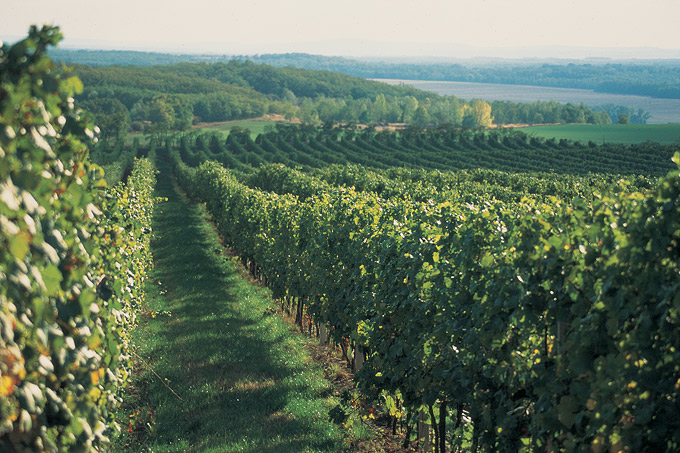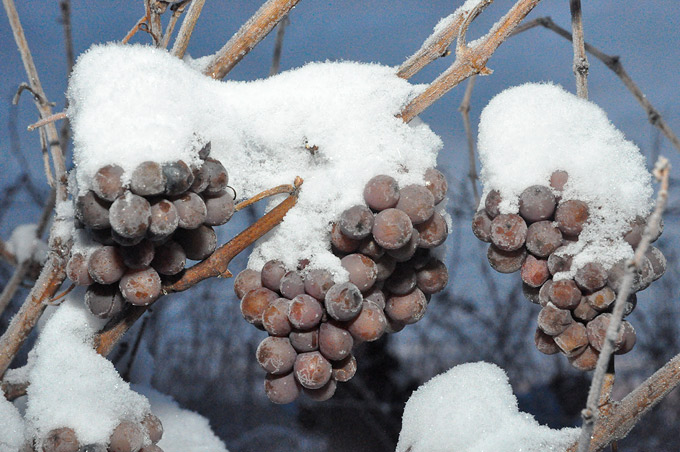Principal varieties of Znojmo Wine Region

The grape variety is the mother of wine.
The terroir is the father of wine.
And the vintage is its destiny.
White wines
Sauvignon Blanc
World-famous variety offers here in Moravia nettle, grassy, peachy or exotic Sauvignons often very similar to New Zealand´s classics. Some wines in some vintages have hints of blackcurrent and preserved gooseberry,. acid with tropical tones. Mineral tones. Always good for keeping.
Traminer (Tramín)
Typical Traminers from southern part of Znojmo wine region are spicy on palate, hints of roses in nose. Very harmonious. Pleasant residual sugar with hints of raisins. Can be kept for several years.
Rhine Riesling (Rýnský ryzlink)
Classical variety producing rich and aromatic wines. Popular dry here. As Ice wine got several inernational awards and gold medals (Decanter, Brussels, Tel Aviv, Vinex Grand Prix etc.)
Green Veltliner (Veltlínské zelené)
Yellow-green berries bring fruity wine with higher acidity and interesting almond flavour. Also like ice wines.
Rulanders
Here in Moravia called Pinot Blanc and Pinot Gris respectively Rulandské bílé and Rulandské šedé. Pinot Blanc is a very reliable variety, giving full bodied, fruity and round wines capable of aging well. Pinot Gris has often soft fruity tones in nose. Mineral tones in taste. In non-dry version pleasant residual sugar from ripen grapes. Very harmonious wines. Honeyed, tones of pears. Tropical tones in fresh acidity. Good for keeping.
Chardonnay
Quite rare here giving full and harmonious wines. Often dried raisins and honey in nose. Mineral tones and pleasant fresh acidity in taste. Great aging potential.
Pálava
Usually available in dry and non-dry versions. Pálava is a crossbreed of pleasant Muller-Thurgau and spicy Traminer. That is why Palava is aromatic wine with very pleasant bouquet. Spicy and flowery in taste. Hints of grapefruit and lemon. Great complexity of flavours. Long and pleasant. Also good for keeping.
Müller Thurgau
Popular variety giving nicely balanced wines with vanilla tones.
Moravian Muscat (Moravský muškát)
It has been developed by crossing Muscat Ottonel and Prachtraube. Grapes ripen early and dry wine has a pronounced muscaty aroma. In non-dry version intensive nose of blackcurrent and citrus. Tropical fruit, acid like tangerine and pleasant amount of residual sugar in taste. Do not age, drink now.
Red wines
Pinot Noir (Rulandské modré)
Noble Pinot Noir from the vineyard of Havraníky often has nose of dark chocolate, over-ripen cherries, silky tannins, red fruit in long pleasant aftertaste. Good for drinking nowbut the wine can be kept several years to mature more. Awarded by several medals.
In rose version notice special orange-raspberry colour. Often hints of raspberry and wild forest fruit in nose. Clean, fresh and light on palate. Can be kept.Zweigeltrebe
A crossing between Frankovka (Limberger) and Saint Laurent. Lively when young, harmonius and rich when matured. Also available in attractive rose version. Fresh piquant wine. Chocolate tones in matured wines. Ideal with goulash or red meats.
Saint Laurent
Popular Central European variety. Wines are full, smooth and dark coloured with soft tannin flavour. Aroma of red fruit and smooth spicy flavour. Often typical fresh acidity.
Ice Wine (ledové víno) and Straw Wine (slámové víno)
Winery Znovín Znojmo has been producing ice wine especially from varieties Grüner Veltliner (Veltlínské zelené) and Rhine Riesling. The vintners také advantage of local climate which is suitable for production of ice wines. Grapes are leaved to freeze in vineyards. Frozen grapes are picked up at quite a low temperature – minimum temperature must be minus 6 according to the Wine Act. The grapes are presssed while frozen. The result in concentrated sticky aromatic juice with extremly high level of natural sugar often around 250 g per litre and also beautifully balanced acidity. Logically production of ice wine is risky because it depends on the weather conditions and expensive as winemakers obtain only 20% of must from frozen grapes.

It can be compared only to Straw wine (Strohwein, Vin de Paille) production. Here concentration of natural sugar is achieved by drying grapes on straw mats for more than 3 months. Pressed dried grapes give about 25 % of must. That is also why appear in the market in quite small bottles. Both types of wines are ideal for long aging – sometimes more than 20 years.



